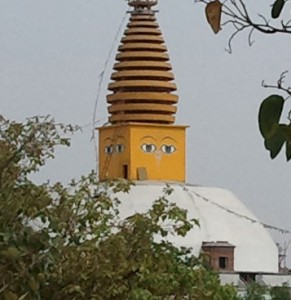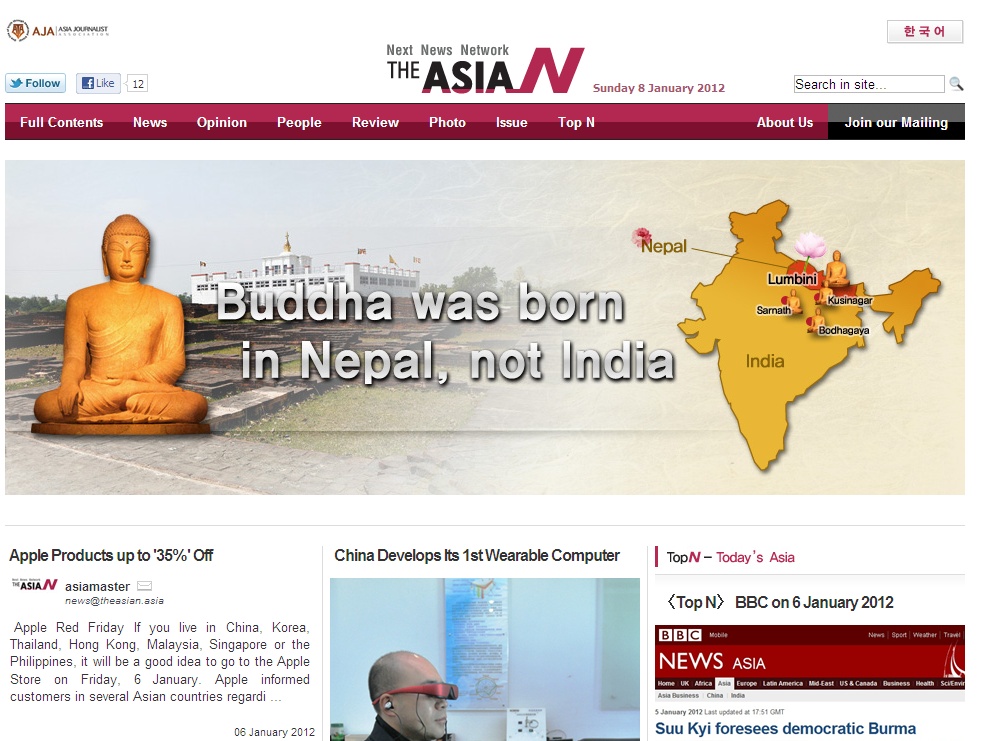
Buddha was Born in Nepal, not India
After the visit of Mauriya Emperor Ashoka some 2256 years ago, many came to Lumbini, the Birthplace of Lord Buddha, until it was buried under a dense forest and remained almost unknown for almost 584 years. The inscription carved in Brahmi script in the Ashoka Pillar erected by Emperor Ashoka in 249 BC reads that the Emperor paid homage to Lumbini on the occasion of the 20th year of his coronation and erected the pillar in the exact birthplace of Lord Buddha.
Ripu Malla, the Khasa king of the Karnali area visited Lumbini and engraved an inscription on the top of the same pillar in 1312 AD. Malla was probably the last noted figure to leave any account of his visit to the site.
According to literary sources, a number of Chinese pilgrims had visited Lumbini from the fourth century onward. Among them Fa-hien and Hiuen Tsiang had visited Lumbini in 403 and 636 AD respectively. Of course, the accounts of these two Chinese pilgrims were what inspired Alexander Cunningham to initiate exploration of Buddhist sites of Indian sub continent in 1890s. The finding of the Ashokan pillar by General Khadga Shumsher and Fuhrer in 1896 ended all speculations about the location of Lumbini.
Further excavation by Indian archaeologist Babu Purna Chandra Mukherjee (P.C. Mukherjee) in Lumbini in 1899 and the finding of the Nativity sculpture (image of Maya Devi) confirmed that Prince Siddhartha was born there.
After Mukherjee, Kaisher Shumsher had excavated the site from 1933 to 1939 and Debala Mitra in 1962. Nepali scholars had also carried excavation and conservation works in the site uncovering a number of Stupas, Viharas and the Puskarini, the holy pond, in which Maya Devi had had a bath before giving birth to Prince Siddartha.
With the findings of Lumbini, many other sites related with the world of Prince Siddhartha were discovered in the following years. The city of Kapilvastu in Tilaurakot including the eastern gate of the Shakya Palace was discovered by P. C. Mukherjee in 1899. This was the very gate from where Prince Siddhartha departed in search of knowledge.
Tara Nanada Mishra, the then senior officer at the Department of Archaeology, found the western gate of Kapilvastu including the defense wall, the watchman’s room during 1967-1972 excavation. The twin stupas of Dhamnihawa, 500 metres north of Tilaurakot are believed to have been constructed commemorating king Suddhodhana and queen Maya Devi, were also discovered.
A remnant of a Vihara was found in Kudan by Ms. Mitra. It is believed that Suddhodhana had constructed it to see Lord Buddha, his son, after he got Enlightenment and refused to enter the Palace in Tilaurakot. He had met his son here and the latter spent a year in the Kudan Bihar.
Two other pillars erected by Emperor Ashoka have been found in Niglihawa, the place of Kanakamuni Buddha, and in Gotihawa, the place of Krakuchhanda Buddha. Both the pillars have been broken and the upper part of Gotihawa pillar has gone missing. Near the Gotihawa pillar is a big stupa. The two pieces of Niglihawa pillar are now lying under a shed.
Sagrahawa, the site where Birudhak had killed 77,777 Shakays lies 3.6 kilometres north of Niglihawa Ashokan Pillar.
Devdhaha and Ramgram are two other sites directly related with the life of Lord Buddha. Both of these sites were under the rule of Koliyas, the mother’s place of Maya Devi whereas other sites fell under Shakyas. Sukra Sagar Shrestha excavated the Stupa of Ramgram in Nawalparasi district some years ago.
Interestingly, all these Buddhist sites can be visited in one go. However, the sad fact is that Lumbini has not yet been able to draw the expected number of tourists. According to the Information Centre of Lumbini Development Trust, Lumbini, 21,151tourists, excluding the Indian tourists, visited Lumbini in the first six months in 2006.
Even many of the tourists who arrive in Kathmandu do not include Lumbini in their destination menu. Also the local tourism entrepreneurs and hoteliers of Lumbini and Bhairahawa, the town located near the holy site, have failed to take advantages from the tourists visiting Lumbini. Instead, the entrepreneurs of bordering Indian cities like Sunauli have been benefiting from them.
“The tourists stay in the Indian hotels of Sunauli and Gorakhpur and the guides ferry them here in reserved buses in the day time. Such tourists who arrive here via India do not spend even a single night in Lumbini or Bhairahawa,” Pashupati Neupane, who teaches tourism at a number of colleges in Kathmandu, said.
Indeed, Neupane is right. Despite presence of posh hotels in New Lumbini Village and transportation, both air and road, facilities Lumbini is yet to be an attractive tourist destination for certain reasons. Even the concerned government authorities seem to have paid less attention to develop Lumbini as a major tourist and pilgrimage site.
“When millions of Muslim pilgrims go to visit Mecca every year, why can’t we attract similar number of Buddhist pilgrims to Lumbini,” questioned Neupane.
“Proper package programmes are a must for the development of tourism in Lumbini.”
When the flow of the tourists in Lumbini is not satisfactory, tourists rarely reach Kapilvastu, the site where the Palace of Suddhodhana was located and other Buddhist sites of the area. Therefore, package programmes as said by Neupane could be a good measure to promote tourism in the area.
The tourists can reach Bhairahawa by airplanes and from the airport the tourist buses will ferry them in all sites. Also they can reach Lumbini directly by tourist buses from Kathmandu. And they will spend at least three nights in Lumbini observing all sites related to the life of Buddha.
Construction of Lumbini International Airport and operation of Lumbini University would be added attraction for the tourists. However, the existing political instability and crises have prevented the government from constructing the said airport and operating Lumbini University. Poor law and order situation has also discouraged many from visiting Lumbini. Also the Lumbini Master Plan designated by Prof. Kenzo Tange and approved by Nepal Government and the UN has not been implemented fully. The Master Plan that should have been fully implemented by 1995, is being implemented at a snail’s pace due mainly to lack of needed resources.
“If we implement the Plan at the current pace, it won’t be materialized even in a period of 200 years,” Hari Kumar Rai, Information and Public Relations Officer at the Lumbini Development Trust, Lumbini, told The Rising Nepal.
However, the progress is not so unsatisfactory. A number of monasteries by different nations have been built in these years in Lumbini. Many pilgrims have been benefited from them. Many of them provide food and lodging facilities free of costs. As a result, the local hotels do not get guests. Lumbini Museum and Lumbini International Research Institutes have come into operation. Lands needed for the implementation of the Master Plan have already been obtained. Lumbini has already been an attractive venue to hold national and international conferences.
Once the Master Plan gets fully implemented, Lumbini will surely be an attraction for the tourists worldwide. However, the authorities designated to promote tourism in the country should work hard to publicize Lumbini and other sites of the area as major tourist and pilgrimage sites. Moreover, efforts should be made to implement the Lumbini Master Plan as soon as possible so as to give a new look to the area and promote it as a Number One pilgrimage and tourist site of Nepal.




